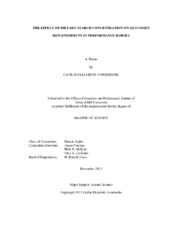| dc.description.abstract | Four Quarter Horses (2 to 3 yr; 401 to 432 kg BW) were used in a simple crossover design for a 49-d study to determine the effect of dietary starch levels on post-exercise glycogen replenishment. Horses were fed either high starch (HS) or low starch (LS) concentrates at 0.75% BW/d plus l.0% BW/d Coastal Bermudagrass hay for 14 d, and then worked to fatigue in a standardized exercise test (SET). After a 14-d washout period, horses were switched to the opposite diet for 14 d and then again performed the SET. The LS and HS concentrates were commercially available feeds. Total diets provided an average of 997.6 g of starch and 553.7 g of starch/d in the HS and LS diets, respectively. Throughout the trial, horses were lightly exercised for 30 min, 3 d/wk. The SET consisted of a 30-min warm-up period at a brisk trot in a panel exerciser, followed by 27 min of gradually ascending high-intensity work on a treadmill.
Skeletal muscle biopsies were taken from the biceps femoris at rest, immediately after the SET, and again at 6-, 24- and 48-h post-exercise. Samples were flash frozen in liquid nitrogen and stored at -80°C until analysis for later muscle glycogen concentration using a commercial kit. Venous blood samples were taken at rest, immediately post exercise and every 15 min for 3 h post-exercise. Blood samples were analyzed for lactate, glucose, total protein and Ca concentration. Data were analyzed using Proc Mixed (SAS) procedure with main effects of sample time, horse, period, trt and time x trt interaction.
Horses on the HS diet had a higher muscle glycogen concentration (P <0.05) at 48 h post exercise than the LS horses (18.1 vs. 10.6 µg/mg wet wt). At 6 h, HS horses had a more rapid rate of repletion, as observed by the higher glycogen concentration (P<0.05) compared to the immediate post-exercise samples (15.4 vs. 7.9 µg/mg wet wt); whereas, the LS horses did not return to normal levels until 24 h post SET. Results indicated that horses on the LS diet, which is representative of low-starch feeding programs commonly observed in the industry, replenish their skeletal muscle glycogen slower than horses on the HS diet. Based on this study, performance horses undergoing multiple bouts of intense exercise may benefit physiologically from receiving diets that contain more than 553.7 g of starch/day. | en |


